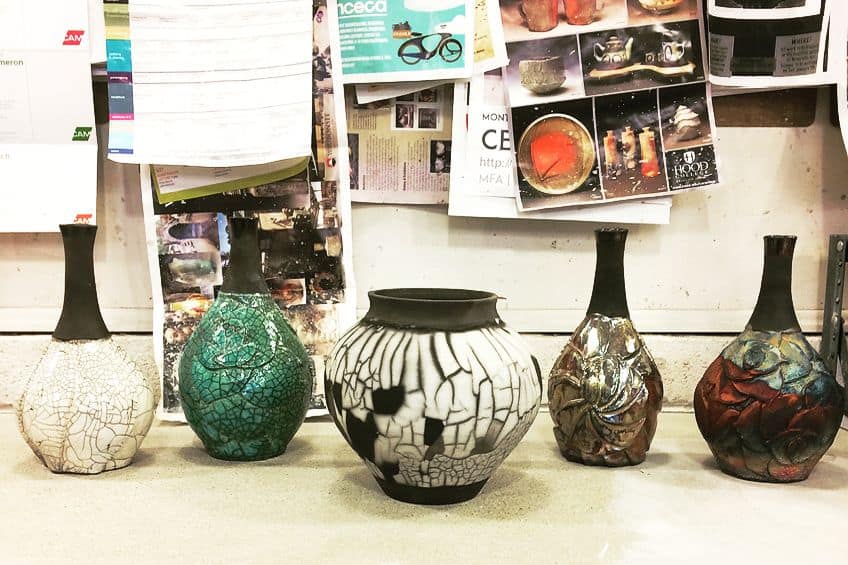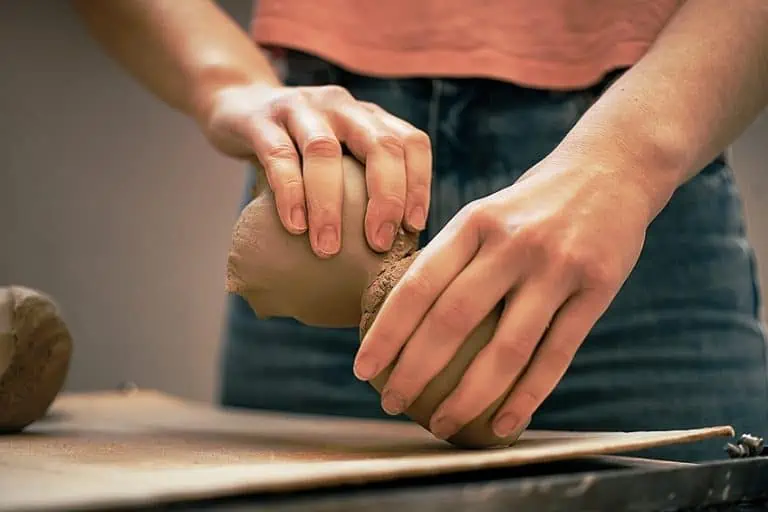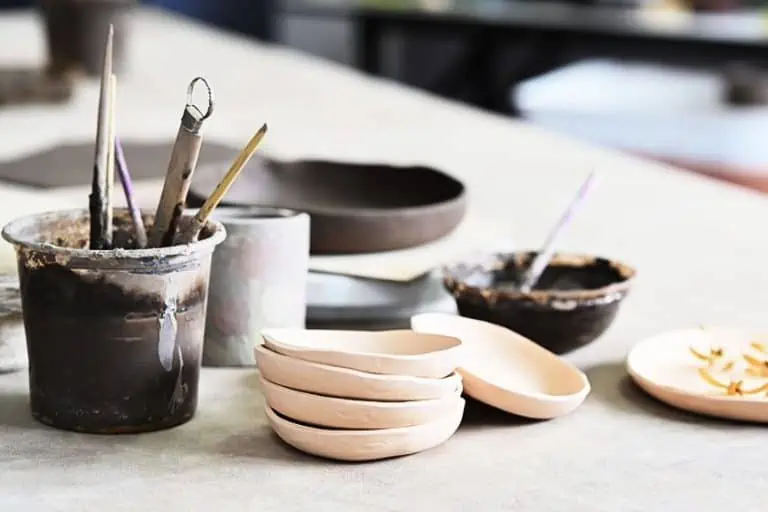What Is Raku Pottery? – Learn All About Japanese Raku Ceramics
This post may contain affiliate links. We may earn a small commission from purchases made through them, at no additional cost to you.
What is Raku pottery and how does the traditional Raku firing process work? Raku ceramics are created using an ancient Japanese Raku pottery process that has been used for centuries. This article will explore the Raku history, as well as the Raku techniques that made this style of pottery so renowned and admired. Join us as we explore the ancient Japanese tradition of Raku firing!
Table of Contents
What Is Raku Pottery?
Raku firing is a traditional Japanese ceramics process that has been utilized for generations to provide pottery with a one-of-a-kind finish. Traditional Raku firing goes back to the 16th century and was crafted by hand rather than on a potter’s wheel. In this process glazed Raku ceramics are removed from the kiln while still burning red hot and then put in materials that can ignite, like newspaper or sawdust.
These Raku techniques are used to deprive the pottery of oxygen, resulting in a spectrum of colors inside the glaze.
 Kiln in a Raku workshop (2018); Aldehoff, CC BY-SA 4.0, via Wikimedia Commons
Kiln in a Raku workshop (2018); Aldehoff, CC BY-SA 4.0, via Wikimedia Commons
Performing the Raku pottery process without glaze results in the oxygen being absorbed from the clay instead of a glaze, resulting in matte black color in some places on the Raku ceramics. Raku firing produces truly unique pieces since there is no way of knowing how the finished ceramic will end up coming out. The Raku pottery process produces a new design each time, therefore there is less control over the result.
The History of the Raku Pottery Process
The famed Japanese tea master, Sen no Rikyū, was engaged in the erection of the Jurakudai in the 16th century and had a tile-maker called Chōjirō manufacture hand-molded tea bowls for use in the tea master’s tea ceremony. The resultant tea bowls manufactured by Chōjirō were first referred to be ima-yaki, which translates to “contemporary ware”. Toyotomi Hideyoshi handed a seal bearing the Chinese character for “Enjoyment” (Raku) to Chōjirō’s son, Jokei. Raku acquired the name of the family that made the items.
Both the name and the Raku techniques have been carried down to the current 16th generation. Raku ceramics have since had a significant impact on Japanese literature and culture.
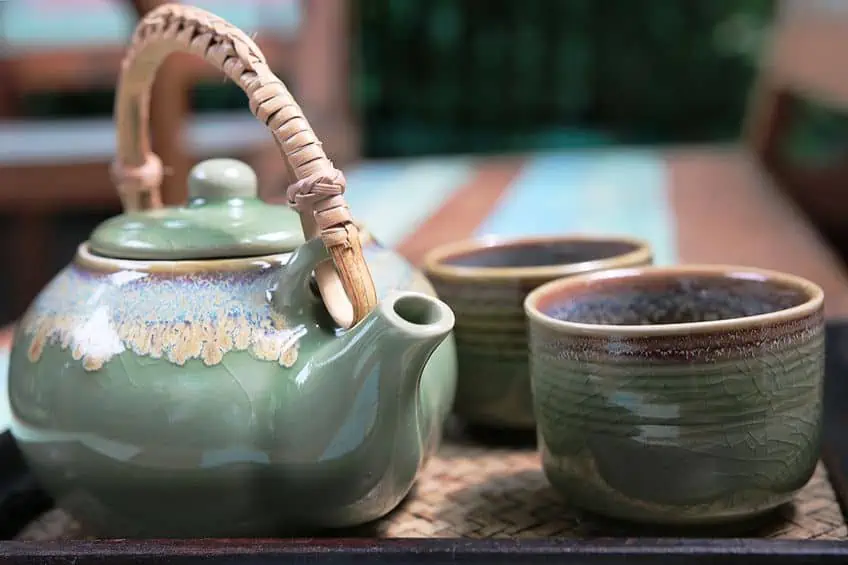
Raku ceramics were also manufactured in several workshops by amateur ceramicists and tea practitioners in Kyoto, as well as by skilled and amateur ceramicists across Japan, after the publishing of a handbook in the 18th century. Raku ceramics was significant in the history of Japanese ceramics because it was the first to adopt a trademarked seal and the first to emphasize closer collaborations between patron and potter.
The Raku Pottery Process and Raku Techniques
Traditional Raku firing requires several important steps to achieve the desired result. The Raku ceramic’s final look is not easy to control, but by properly adhering to Raku techniques, can you at least be assured that you will attain the signature Raku aesthetic. In this section, we will look at the various steps of the Raku pottery process, and how each aids in the final look.
The Preparation and Shaping Stage
How the clay is prepared and shaped will play a large role in how the final piece of pottery looks, therefore, it is important to get this stage right from the beginning. The ultimate outcome of the fire is heavily influenced by the preparation and shape of the clay pieces. The type of clay you use when Raku firing is critical since it influences the final glaze finish. Raku clay is often low-firing and porous, allowing the glaze to absorb during the firing stage.
After the clay is selected, it is shaped using a range of hand-building techniques, as the potter’s wheels were not utilized.
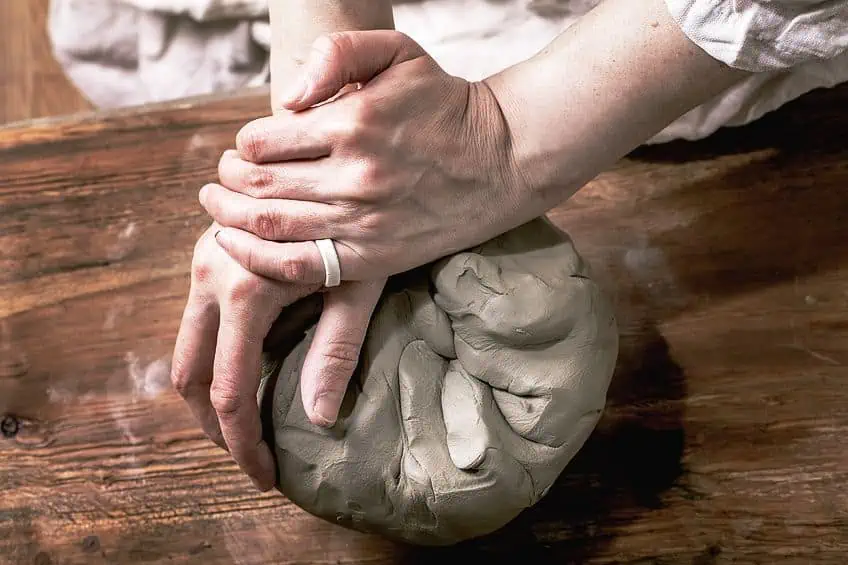
These techniques included coiling and slabbing. Coiling is a three-dimensional process that includes rolling out long clay coils and piling them on top of each other. To achieve a smooth surface, the coils are often smoothened out and merged together. Slabbing is the process of rolling out flat sheets of clay, cutting, and connecting them together to produce the desired form.
The Bisque Firing and Glazing Stage
Raku firing is significantly faster than the usual firing technique, requiring only one to two hours as opposed to up to 24 hours for standard firing. The first step of this stage is to glaze your piece with a Raku glaze, which can be bought at numerous pottery equipment distributors and craft stores. These glazes are carefully formulated to have a very low melting point, allowing them to melt at cone 06 in roughly 60 minutes. A thin coating of glaze is preferable for the traditional Raku firing to be the most effective.
The next step involves loading the kiln with your piece and heating it to 1850 degrees Fahrenheit, which will most likely take around 60 minutes.
Make sure to check in on the Raku ceramic every quarter of an hour or so after 45 minutes of firing to verify that the Raku pottery process is still going smoothly without any noticeable issues. If your glaze begins to bubble, the process is nearing completion! When the glaze begins to bubble, leave it for another quarter of an hour before proceeding to the next stage. When your Raku ceramic is flaming red and the glaze surface seems slick and liquified, it is time to remove it from the kiln.
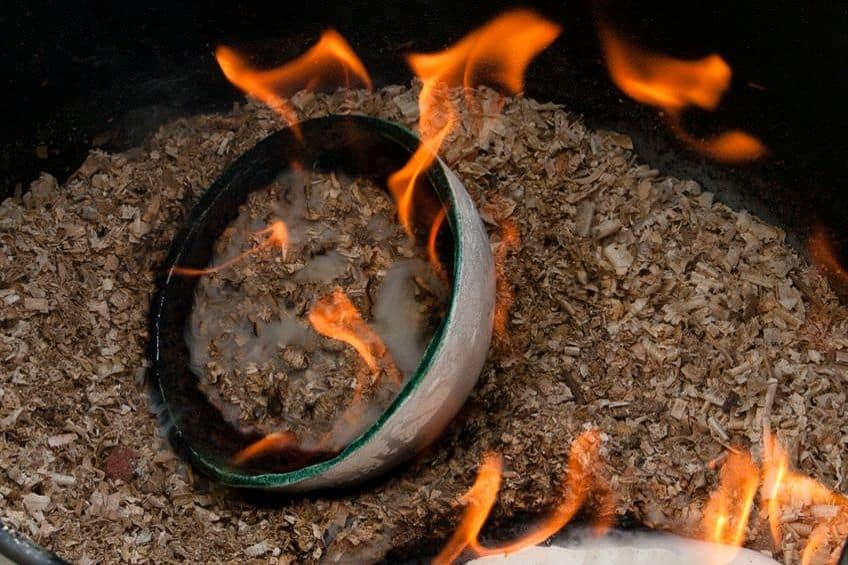 Reduction firing on Raku ware (2014); Dirk Ingo Franke, CC BY-SA 4.0, via Wikimedia Commons
Reduction firing on Raku ware (2014); Dirk Ingo Franke, CC BY-SA 4.0, via Wikimedia Commons
While you wait for the kiln process to finish, you can prepare your vessel for lowering the oxygen to the ceramic. Sawdust or shredded newspaper should be deposited in a metal trash can or similar container. The containers should only be slightly larger than the contents of the vessels. The narrower the region surrounding the piece, the higher the oxygen reduction, resulting in a richer color spectrum.
Raku Firing Stage
The Raku process will require three individuals after the piece has reached a red-hot glow. One person will need to open the door of the kiln, another must use the tongs to remove the piece from the kiln and put it into the container, and a third will need to close the vessel’s lid. Wear suitable protective clothing at this stage because you are working with very hot materials. When the pottery is withdrawn from the kiln, its door must be closed between each piece brought out to maintain a consistent temperature.
Put the pieces in the waiting containers as soon as possible to ensure that the heat does not dissipate. The third person should wait for the flammable material to catch fire before closing the vessel lid quickly and smoking the piece.
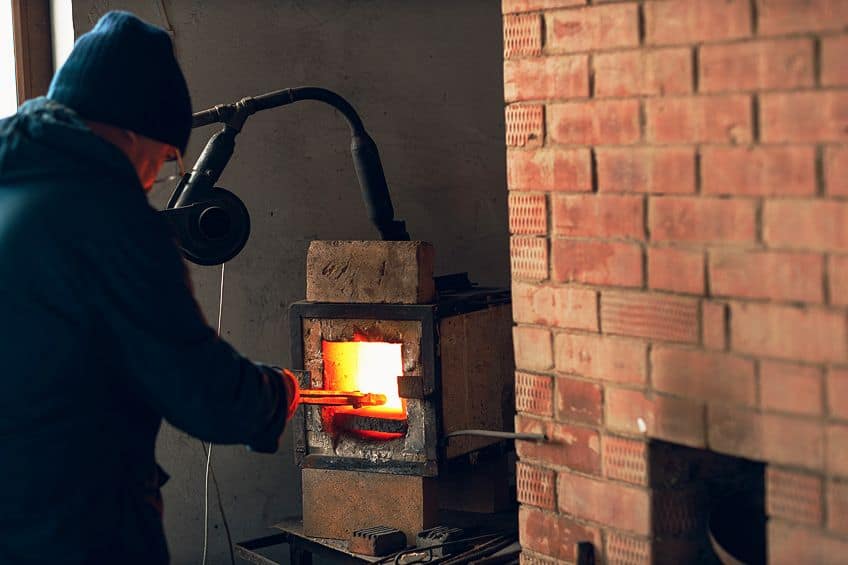
The following step is to hang back for a couple of minutes while the smoking process takes effect. Take caution when removing the lid since the smoke will be very hot and might potentially cause burns to your face if not done correctly. Furthermore, the pieces are still incredibly hot at this time, therefore, handling them should be done with extreme caution. Pour some water onto the ceramic to cool it down, then take it out with tongs and immerse it in a bucket of water. You should be able to see the visual effect of the process on your final piece at this stage.
The Distinctive Characteristics of Raku Ceramics
Raku ceramics often have a cracked glaze, with a network of small lines or fractures that emerge in the glaze during the firing process. This is due to the fact that the glaze is added to the piece prior to firing, and when it heats up, it shrinks more than the clay body beneath, causing it to split. The glaze on Raku ceramics is typically shiny or iridescent, with hues ranging from earthy greens and browns to vivid purples and blues.
This is due to the fact that the reduction environment within the container during firing may cause metallic components in the glaze to change color, resulting in a variety of intriguing and unanticipated effects.
Glazing and Color Variations
What distinguishes Raku Ceramics is the variety of designs that can be made by merely changing a few factors. The outcome of burning a piece of clay is ultimately determined by these variables, which include glazes, wax resist, slips, temperature, and time. Let’s look at these in more detail.
Wax Resist
Wax resist, which is painted over raw clay, is a wax suspension in water. This is done to prevent the glaze from covering the region where the wax resist was put, resulting in a pattern. The wax melts away in the kiln, and the carbon produced by oxygen reduction replaces it.
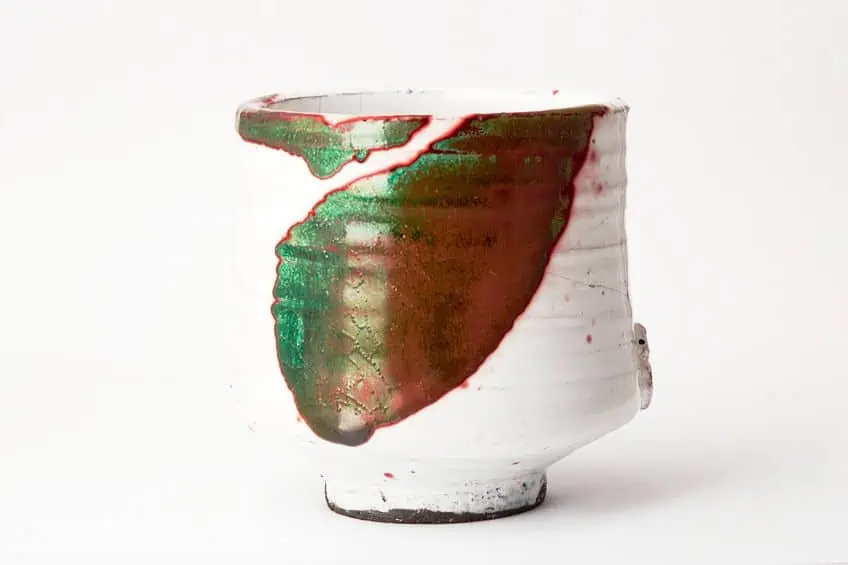
Crackle Glaze
Metallic components like iron, copper, and cobalt are present in crackle glazes. When the glaze reaches a specific temperature, the metal reacts and takes on a certain hue. Cobalt, for instance, provides a darker blue hue, whereas copper makes a greenish color but can also generate a red when the oxygen is totally removed. Cracking can occur as a result of temperature changes and the redox process.
The hues of each color are directly affected by the time of removal and subsequent placement in water.
Copper Glaze
Copper glazes are not the same as crackle glazes. While the former is purposely subjected to cooling and oxidation for the glaze to crackle, the copper-glazed pieces are moved from the heat to the reduction chamber as fast as possible. This enables the glaze to experience as much reduction as possible and can bring out brilliant flashes of color from the glaze, resulting in a finish that can be either glossy or matte, depending on the kind of glaze used.
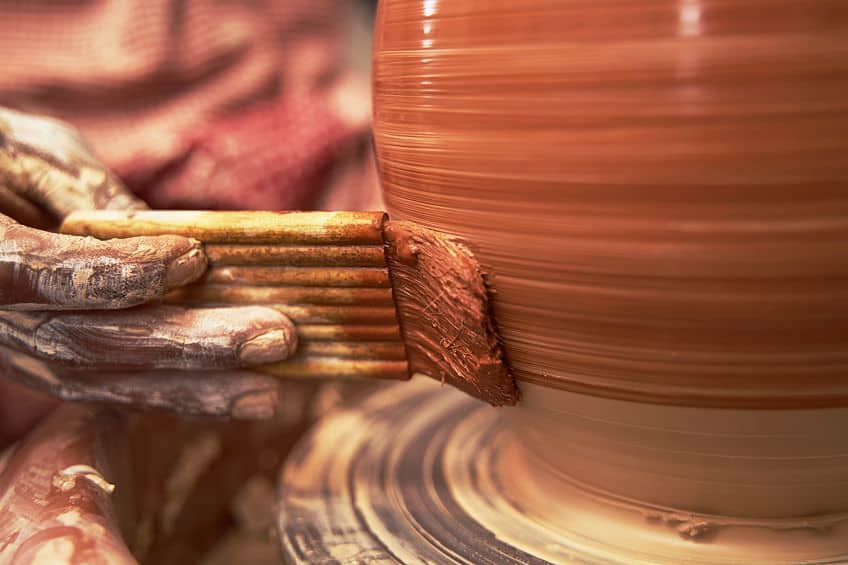
Horsehair
When the object achieves a certain temperature in the kiln, it is put in the open air instead of in the reduction chamber, and horsehair is strewn on the piece in a strategic manner, it is known as horsehair reduction. The horsehair burns quickly and forms tiny linear lines on the Raku ceramic.
The Fragility and Durability of Raku Ceramics
Because of the unusual firing method used to manufacture them, Raku ceramics are often thought to be more delicate and less durable than other forms of ceramics. The quick cooling that happens during the Raku pottery process might make ceramics more prone to cracking. In addition, the reduction environment created inside the container during firing might make the glaze more sensitive and prone to chipping or flaking.
This is particularly true for ceramics with metallic or iridescent glazes, which can be exceedingly delicate.
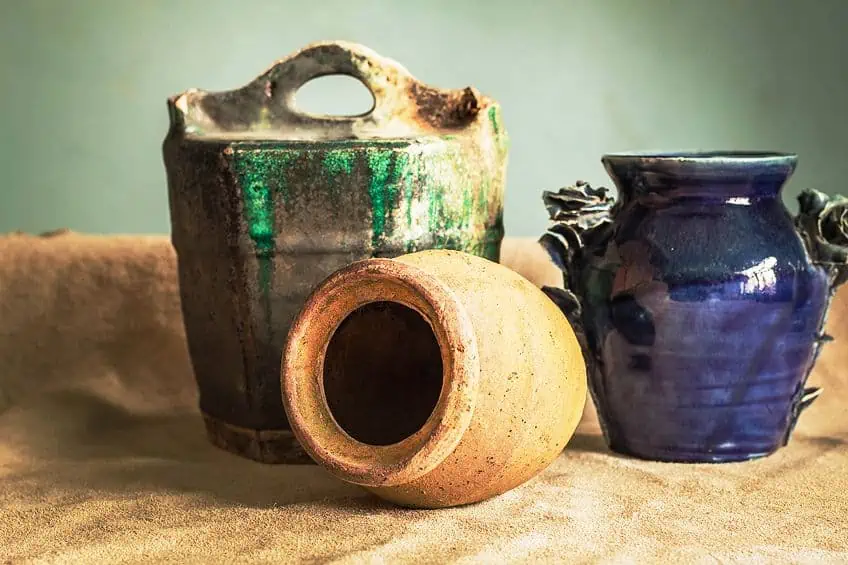
However, the fragility and delicate aspect of Raku ceramics contribute to its allure and appeal. The fractures and defects that may develop during the traditional Raku firing process are viewed as part of the work’s beauty, and collectors admire each piece’s individual character and textures. Raku ceramics are fragile and should be handled with care and displayed in a secure location to avoid unintentional damage. Raku ceramics may be enjoyed for many years and remain a treasured work of art with careful care and handling.
The Uses of Raku Ceramics
Raku pottery is very striking and pleasing to look at, therefore, it is no surprise that pieces are valued as decorative works. However, Raku pottery can also serve various utilitarian and cultural functions. Let us now take a closer look at the various uses of Raku ceramics.
Decorative Use
As stated above, because of their distinctive and appealing appearance, raku ceramics are frequently utilized for ornamental purposes. Raku works are popular for exhibiting in galleries, museums, and even private residences due to their cracked glaze and iridescent finishes. Raku pottery can be presented as an isolated focal point as part of a larger arrangement of pieces. Raku ceramics are appreciated for their tactile properties as well as their aesthetic appeal. Raku sculptures’ cracked surface and rough textures may be appreciated through touch. However, Raku ceramics should be displayed in a secure area and handled with care because of their fragility.
They should preferably not be used for food or drinks since the ceramics may not endure everyday wear and tear.
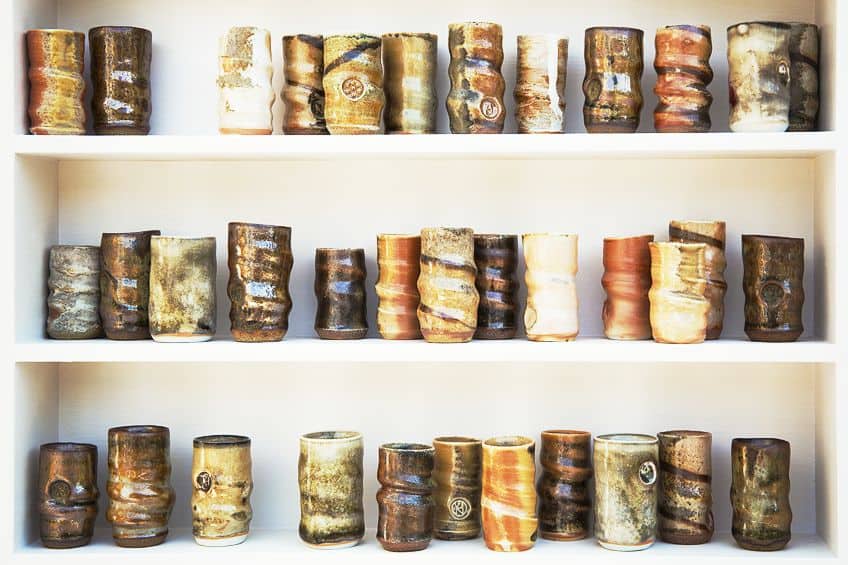
Functional Use
While Raku ceramics are often regarded as more delicate and less lasting than other forms of pottery, certain Raku ceramics may be used to store non-food objects Raku vases and bowls, for instance, could be used to store little objects or dried things such as potpourri or ornamental stones. Raku platters can be served on or used as decorative trays. Raku ceramics’ distinct textures lend interest and elegance to commonplace objects.
It is very important to remember, though, that not all Raku ceramics are suited for functional usage. Raku ceramics are prone to chipping, cracking, and shattering because of their fragility.
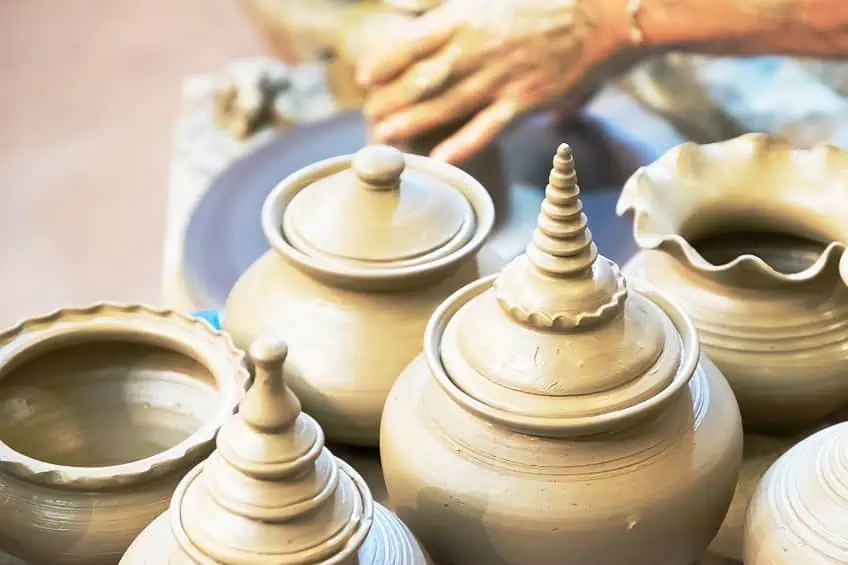
Before employing Raku ceramics for practical reasons, it is very important to consider its intended application. Before using it for serving or keeping food, make sure that the glaze on the ceramic is safe for food. Because certain Raku glazes may include heavy metals or other dangerous compounds that might leach into whatever is kept in them, it’s crucial to check the glaze’s safety before using it for food.
Traditional and Cultural Use
Raku pottery has been culturally significant for many centuries, notably in Japan, where it originated. It was initially designed for use in tea ceremonies, and it is still used in this capacity today. Sen no Rikyu, a Japanese tea master, ordered the first Raku ceramics for use in the tea ceremony in the 16th century. These pieces were prized for their rustic simplicity, which contrasted with the formal grandeur of other forms of tea ceremonial ceramics. Raku ceramics’ distinct textures and surfaces were particularly praised for their tactile properties, which enhanced the overall sensory experience of the ceremony.
Raku ceramics are still used in tea ceremonies both in Japan and across the world today.
Famous Raku Ceramic Artists
In this last section, we will look at a few notable Raku ceramicists. Hon’ami Koetsu is regarded as a significant figure that greatly inspired the style. Chōjirō is regarded as another notable figure in its development. Even today, there are people who create Raku ceramics. Let us take a look at these notable figures a little deeper.
Chōjirō (1516 – 1592)
| Name | Chōjirō |
| Nationality | Japanese |
| Date of Birth | c. 1516 |
| Date of Death | c. 1592 |
| Place of Birth | Kyoto, Japan |
Chōjirō was a ceramicist from Japan who established Raku pottery art. He was born into a pottery family in Kyoto and learned the craft from his father and grandparents. Sen no Rikyu asked the ceramicist to produce ceramics for use in the tea ritual. Chōjirō invented a new sort of pottery that was rather rustic in appearance and was intended to match the look of the tea ceremony. His Raku ceramics were highly valued for their distinct beauty and tactile features. His Raku ceramics are now regarded as classics of Japanese art and are widely sought after by both museums and collectors worldwide.
His descendants and other ceramicists who have been shaped by his work continue to practice the tradition that he established.
Hon’ami Koetsu (1558 – 1637)
| Name | Hon’ami Koetsu |
| Nationality | Japanese |
| Date of Birth | c. 1558 |
| Date of Death | 27 February 1637 |
| Place of Birth | Kyoto, Japan |
The Japanese artist, Hon’ami Koetsu, was very influential in the development of Raku ceramics. He was a master of several ancient Japanese arts, notably lacquerware, calligraphy, and ceramics, and is regarded as one of the most significant characters in Japanese art history. Koetsu was a key figure in raising Raku ceramics to the level of fine art. He was a personal friend of Chōjirō, the creator of traditional Raku firing. Koetsu appreciated Chōjirō’s basic approach to pottery, and they worked together to develop a new type of Raku ceramics that merged traditional Raku’s rustic simplicity with Koetsu’s own creative sensibility. Koetsu used his own calligraphy and patterns to design and adorn his Raku pottery, making them works of exceptional beauty and creativity.
He also employed Raku pottery in his tea ceremonies and was instrumental in popularizing Raku ware in traditional tea culture.
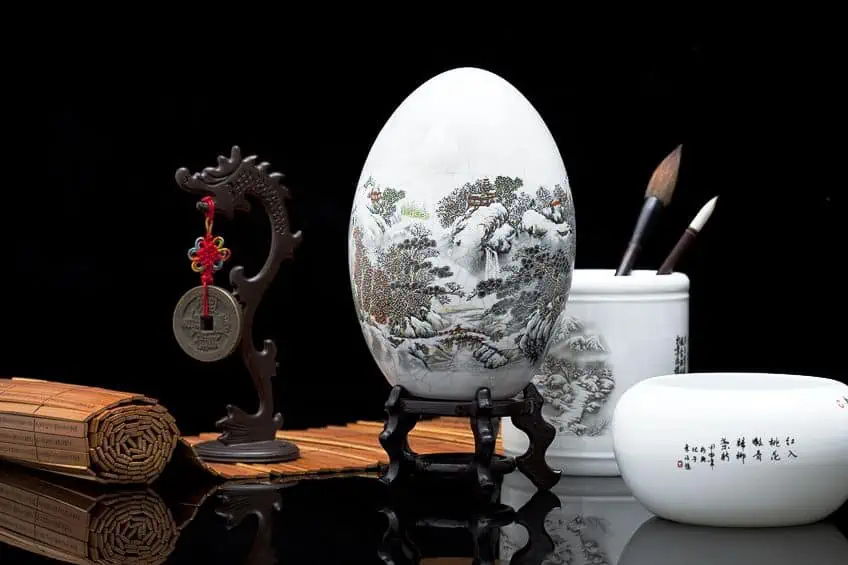
Raku in the Modern Era
Many current Raku ceramicists are still carrying on the Raku pottery legacy by making beautiful and unique works. Bernard Leach is credited for introducing Raku to the Western world. He went to a party in 1911 and watched the Raku firing process. This was his first time working with ceramics. Although he experimented with Raku firing for a few years after returning to England in 1920, the method was completely forgotten by the 1930s. With the guidance of Paul Soldner, Raku became popular among Americans in the late 1950s.
They preserved the traditional Raku firing method but developed their own style of Raku.
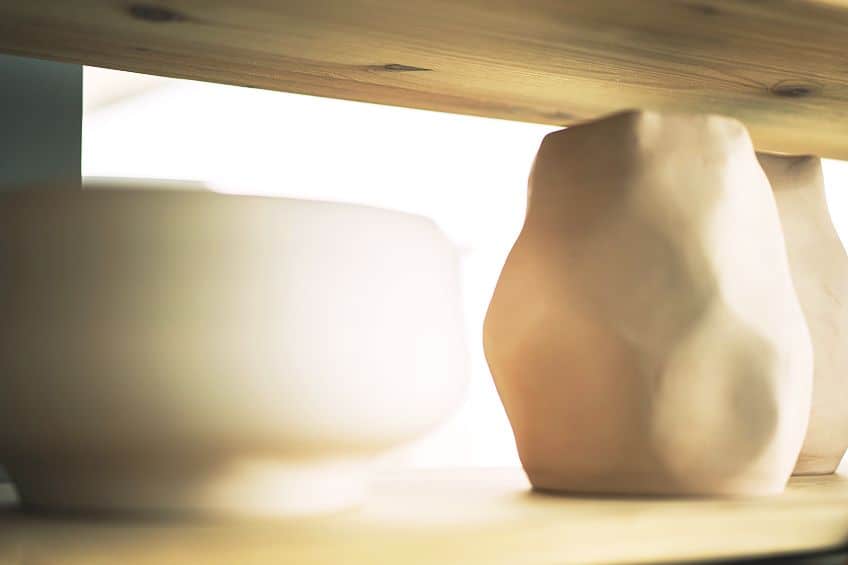
Unlike traditional Raku ceramics, which are mainly handcrafted bowls of modest design, Raku in the Western world is vibrantly colored and comes in a variety of sizes and forms. Western Raku can range from an exquisite vase to a surreal abstract sculpture. Although some Raku pieces are hand-built, most Western ceramicists make use of throwing wheels to produce their Raku wares.
In this article, we covered the history of Raku, as well as the various methods and designs that are associated with it. Thanks to the inventive potters of ancient Japan, we have a range of interesting designs that we can make using this method. While Raku ceramics are beautiful, one must remember to handle them with care due to their fragile nature. However, if one looks after them well, they can serve as striking conversation pieces in any environment.
Frequently Asked Questions
What Is Raku Pottery?
It is a type of pottery that is made by hand and undergoes a process that results in a distinct finish. Raku pottery was initially used in traditional Japanese tea ceremonies. Today, the pottery is used as decorative pieces, as well as for various utilitarian functions. The Raku pottery process continues to be used by potters right into the present day.
What Is Traditional Raku Firing?
Raku firing is a ceramic firing technique that first originated in Japan. Raku techniques involve heating the piece to a high temperature and then rapidly cooling it. To obtain the desired result, the Raku pottery process is repeated numerous times. It is a very unpredictable process with vastly different outcomes depending on the materials used and the firing circumstances.
In 2005, Charlene completed her wellness degrees in therapeutic aromatherapy and reflexology at the International School of Reflexology and Meridian Therapy. She worked for a company offering corporate wellness programs for several years before opening her own therapy practice. In 2015, she was asked by a digital marketer friend to join her company as a content creator, and it was here that she discovered her enthusiasm for writing. Since entering the world of content creation, she has gained a lot of experience over the years writing about various topics such as beauty, health, wellness, travel, crafting, and much more. Due to various circumstances, she had to give up her therapy practice and now works as a freelance writer. Since she is a very creative person and as a balance to writing likes to be active in various areas of art and crafts, the activity at acrylgiessen.com is perfect for her to contribute their knowledge and experience in various creative topics.
Learn more about Charlene Lewis and about us.
